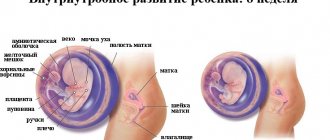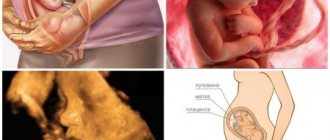The last, ninth month of pregnancy has arrived: the woman and the baby, almost ready to get acquainted with the new world, which is still “stationed” in the tummy, are reaching the “finish line”. With the onset of the ninth month of pregnancy, labor can begin at any time, and you should not be afraid of this - in the ninth month the baby is already considered full-term, the small body is quite ready to face the conditions of the outside world. And by this time the woman should be ready “fully armed”: probably the essential things for the maternity hospital are already waiting in the wings, the nursery for the long-awaited baby has already been equipped, and the mother listens to herself every day, waiting for the start of real, and not training, contractions .
Woman's feelings
By the 38th week of gestation, the expectant mother “gets tired” of her position:
- she is tormented by her clumsy gait;
- dyspnea;
- difficulties in performing everyday activities;
- restriction of actions;
- fast fatiguability.
The skin on my stomach continues to stretch. Stretch marks that appeared in previous months increase in size and become significantly lighter.
A pregnant woman is overcome by unbearable itching and the epidermis on her face is peeling. Pigmentation increases and sometimes hair falls out.
The weight of the fetus puts pressure on the inguinal ligaments and pubic bone, which results in a painful “dull” sensation.
A pregnant woman is counting the days until her expected due date, but the birth of a baby can happen completely unexpectedly. Mommy can determine the day of birth herself.
To do this, you should use the old proven technique:
- Subtract 3 months from the first day of the last menstruation;
- Subtract 5 days from the received date;
- It turns out the approximate date of birth of the baby.
More precisely, the decisive date is determined by ultrasound methods and gynecological examination.
In the final trimester, a woman prepares for the birth of her baby. Buys things, furnishes the room for the newborn, and does not forget about hygiene supplies.
Medical examinations
The 9th month is the most difficult period of time. After all, it is already difficult for the expectant mother to walk, and she will have to visit the doctor more than once this month.
The doctor will measure blood pressure and refer the woman for various tests, including studies of the child’s vital signs - ultrasound, CTG.
In addition, the gynecologist will take vaginal discharge for analysis. This is necessary to make sure that there is no pathogenic flora that can be transmitted to the baby during the birth canal.
Other studies are also carried out, the decision to conduct them is made by the doctor based on other indications.
How does the fetus behave?
At the time of nine-month development, the formation of all organs and systems in the fetal body has been completed. The immune system remains imperfect; during breastfeeding, it will complete its formation due to maternal antibodies.
The baby is ready to be born:
- he can breathe on his own;
- he has a developed sucking and swallowing reflex;
- the intestines process food;
- the urinary system works.
Urine and original feces meconium are released into the amniotic fluid.
During the 36-39th week of gestation, boys' testicles descend into the scrotum.
The formed own central nervous system begins to work, the “thinking” process starts.
The circulatory and cardiac systems are ready to supply the baby extrauterinely.
Subcutaneous fat tissue actively accumulates. The baby's weight varies from 3 to 5 kg. Height is 47-52 cm.
The baby's motor activity noticeably decreases, since there is not enough space in the uterine cavity.
Normally, the child should be positioned head down, so stretching after sleep manifests itself as a pressing force on the pubic bone and blows to the hypochondrium.
The baby knows how to catch his mother’s speech and respond to it by sticking out his butt or legs.
Changes in a woman's body
Mature pregnancy is accompanied by a number of significant changes in the female body. The volume of circulating blood increases, which leads to the formation of edema.
The load on the legs increases, and even at the end of the gestational period, the formation of thrombophlebitis or varicose veins is possible.
The hormonal background gradually changes. The production of prolactin, the hormone responsible for the arrival of breast milk, increases.
Due to the synthesis of the hormone, a viscous, thick liquid may appear from the nipples. You can’t squeeze it out, or massage your breasts in any other way, since prolactin causes uterine contractions.
Nausea in the 9th month of pregnancy fades into the background, as the changed position of the fetus (upside down) takes the load off the lungs and esophagus.
The pregnant woman no longer suffers from heartburn and constant discomfort in the epigastric region.
During the rest period, the woman takes a horizontal lateral position with her legs raised. At 9 months of gestation you should only sleep on your side. Mainly on the right, to minimally reduce the load on the circulatory system.
Lying on your back causes pain in the lumbar region and increases the load on the spine.
At this stage of bearing a baby, signs of labor activity or “precursors of labor” appear:
- urination becomes more frequent;
- training contractions intensify and become more frequent;
- periodically pain appears in the lower abdomen, radiating to the perineum;
- breathing becomes easier;
- the stomach drops;
- Fetal activity decreases.
Changes also apply to vaginal discharge. They acquire a more liquid character. The color is mostly transparent, but sometimes with a yellowish tint.
The appearance of yellow, brown or red streaks indicates the passage of the mucus plug and the approaching birth.
Problems of pregnancy in the last month and their solution
In the last month, difficulties may arise on both the mother’s and the baby’s sides, but often these problems appear and are detected earlier.
Problems from the baby
The child may have:
- umbilical cord entanglement. If it was not present at the last ultrasound, this does not mean that it will not appear before birth, because the baby moves in the womb. It is diagnosed on a control ultrasound before the birth itself, during contractions. Depending on the complexity of the situation, a decision is made on the safest type of delivery;
- dangerous location in the uterus. Not all children before birth take the correct position with the back of the head towards the exit of the uterus; frontal, facial, pelvic and transverse presentations are possible. They are dangerous for the baby, as they can cause serious injuries as they move through the birth canal. Having assessed the position of the fetus during a control ultrasound, doctors assess the risks and decide whether to allow a natural birth or a cesarean section;
- complete placenta previa is a situation when the baby's place blocks the exit from the uterus and makes natural movement along the birth canal impossible. This is detected even at the first screenings, but with the onset of contractions it can become a source of severe bleeding, threatening the lives of both the baby and the mother. The only solution to the problem is a caesarean section, which is often performed electively.
Problems on the mother's side
It is very important for the expectant mother to control her weight - excessive weight gain in the last month (more than 2 kg) may indicate fluid accumulation in the body and edema, which indicates the development of a dangerous condition called gestosis or late toxicosis. Gradually, the swelling is accompanied by the appearance of protein in the urine and increased pressure, which confirms the diagnosis. Therefore, if the rings become difficult to remove, and traces of the elastic bands of socks and tights remain on your legs and waist, then you should immediately go to the doctor. In the last month, the following problems may become especially relevant:
- Varicose veins are a consequence of compression of the veins in the abdominal cavity due to the increased size of the uterus. To combat the disease, you need to contact a phlebologist, who will prescribe medications to prevent the condition from worsening and treatment after childbirth;
- symphysitis - pathological changes in the tissues of the symphysis pubis, which cause divergence of the pubic bones (more than 5 mm). The condition is accompanied by severe pain during any physical activity and movement, which occurs precisely in the last months of pregnancy. Treatment consists of prescribing anti-inflammatory and painkillers. The ability of a woman with symphysitis to give birth on her own is determined by doctors based on the complexity of the picture.
In the last months of pregnancy, the expectant mother may develop symphysitis - separation of the pubic bones
Analyzes and research
Weekly visits to the gynecologist can be changed to inpatient monitoring, if there is reason.
The examinations include:
- blood pressure measurement;
- Fetal CTG;
- weighing;
- abdominal girth and uterine height.
Urine is collected for protein and sugar detection, blood is collected for general analysis and coagulogram. For mothers with complications of gestation, additional types of laboratory tests and ultrasound of the fetus are indicated.
Ultrasound diagnostics is carried out no later than 38 weeks. The degree of maturity of the placenta and fetal lungs is determined. The main goal is to identify the readiness of the birth canal for the passage of a child through it.
In maternity hospitals, a gynecological examination of the pregnant woman is performed on a chair to identify the stage of cervical dilatation and the location of the fetus and child's place.
Sex in the ninth month of pregnancy
Whether sex is possible in the ninth month of pregnancy is determined by the doctor leading the pregnancy. There are very mixed opinions about whether intimate relationships are permissible in the last month. Thus, some experts recommend abstaining from physical intimacy in the last weeks of pregnancy, since sex can provoke labor ahead of schedule. Other experts see nothing dangerous in the fact that mom and dad allow sex in the ninth month of pregnancy. Of course, provided that there are no serious contraindications for physical intimacy, in particular, the presence of a threat of premature birth, leakage of amniotic fluid, low location of the placenta, multiple pregnancy.
In general, it is up to the doctor to decide whether to have sex in the last month of pregnancy. If the specialist has given the “red color”, you should choose the most comfortable positions for sex, eliminating pressure on the mother’s stomach. The optimal positions are considered to be on your knees or on your side.
By the way, sex can be one of the methods of natural stimulation of labor if the baby “lingers” in the tummy longer than expected. Thus, male sperm contains substances called prostaglandins, which have the ability to soften the cervix and cause its contractions.
Allowed physical activity
Excessive activity of a potential mother can cause a hypoxic state of the baby due to entanglement in the umbilical cord. However, at the 9th month of an “interesting” position, this phenomenon is rare.
Increased body weight and a round, protruding belly are a limitation in performing any physical activity.
Pregnant women are recommended to spend time in the fresh air, continue to engage in training movements and special gymnastics.
It will not be superfluous to study the correct behavior during childbirth, namely breathing and control of pushing.
Daily household chores (cooking, cleaning) are performed with breaks for rest. Women expecting replenishment need proper rest and nutrition in the last weeks.
Psychological comfort of the expectant mother in the 9th month
After feeling heavy and tired over the past few weeks, you may suddenly find yourself with more energy in the final month of pregnancy. You'll likely want to spend it on cleaning the house and making other preparations before giving birth. Many women have similar desires - this is how the “nesting instinct” manifests itself.
- If the urge to clean up the house is irresistible, do not resist, organize the space around as you see fit for yourself and the expected baby. But save your energy: you need it during childbirth.
- You may have already chosen a name for your baby. If you don't know what gender your newborn will be, most likely you have at least two options prepared - for a girl and for a boy. It's also possible that you have a priority list of names and will decide which one suits your baby best when you finally see him. You can learn how parents choose a name from our article “Choosing a name” (https://agulife.ru/calendopedia/luchshee-imya-dlya-rebenka).
- You may be worried about your new life as a mother, how the birth will go, what the baby will be like. Your anxiety is completely normal - all women go through it. Try to calm your fears and doubts, communicate more with loved ones and, if possible, consult a trusted psychologist.
What is prohibited and restricted
The following are prohibited:
- lifting weights over 2 kg;
- smoking and drinking alcoholic beverages;
- abuse of bakery products.
During the gestational period, especially at the end of the third trimester, you should not engage in active sports, cycling or swimming.
Long trips and flights are not recommended.
Every time you leave home, you must take documents with you: passport, insurance policy, exchange card and pregnancy certificate. At the beginning of the ninth month, a bag should be packed for visiting the maternity hospital. You can get a list of necessary things from your treating gynecologist-obstetrician.
Precursors of labor in the ninth month of pregnancy
It was already mentioned above that, starting from the ninth month of pregnancy, labor can begin in any of the next four weeks. Moreover, not a single doctor will undertake to accurately and unambiguously calculate the day when the baby “decides” to leave the mother’s tummy - even during an ultrasound, a woman is told only the approximate date of birth.
But, at the same time, the so-called harbingers of childbirth will tell the pregnant woman that the cherished “hour X” is approaching. Some of them have already been discussed, namely: prolapse of the abdomen (when the baby moves its head into the pelvic area) and increased frequency of urination.
In addition to these mentioned signs of approaching labor, the imminent birth of a child can be “signaled” by a slight decrease in body weight. A loss of 1-2 kg a few days (weeks) before giving birth is explained by hormonal changes, and may also occur due to decreased appetite and loss of some fluid.
You can also know that childbirth is just around the corner by the release of the mucus plug. So, as the cervix ripens, its canal begins to open slightly; accordingly, a mucous plug emerges from the cervix, which closed the canal throughout pregnancy. A woman will know about the release of a mucus plug by finding a lump of colorless or yellowish mucus on her underwear, possibly streaked with blood or blood-stained mucus.
While the body is in every possible way completing its “preparation” for childbirth, it is necessary to prepare as much as possible for this important event: finally decide on the maternity hospital, prepare all the things that will be needed after childbirth (underwear and clothes for yourself and the baby, a bag with cosmetics and hygiene items). When leaving home, a woman must always have her passport and exchange card with her.
Nutrition
The diet includes light and low-calorie foods.
The weight of the pregnant woman and the fetus is fixed and does not depend on the amount of food consumed. An excess of permissible calories negatively affects the process of giving birth to a baby.
Required products are:
- fresh vegetables;
- fruits, but not citrus fruits;
- cottage cheese or kefir;
- porridges and slimy soups.
Restrictions apply to fish products, meat products, bread and sweet compotes.
Legumes, milk, fatty or fried foods, potatoes, eggs, cream cakes and salt are completely prohibited.
The diet remains split with two fruit snacks.
The amount of fluid is reduced to 1 liter per day plus 1-2 mugs of unsweetened tea.
Nutrition in the ninth month of pregnancy
In the last month of pregnancy, you should definitely pay attention to organizing proper nutrition: the process of the upcoming birth and the well-being of the new baby largely depend on what and in what quantities a woman now consumes food.
Thus, in the last stages of pregnancy, it is recommended to completely exclude from the diet allergenic foods that can cause the development of allergies in the child. In addition, you should avoid soft, unpasteurized cheeses, pates, and canned foods, which can become a “source” of intestinal infection.
It is necessary to slightly “adjust” the usual pattern of eating foods containing calcium (primarily dairy and cottage cheese). If during the second half of pregnancy the need for calcium is indeed significantly increased, its excessive consumption in the last months may subsequently result in the rapid closure of the fontanel in the child and the associated increase in intracranial pressure. To provide the body with calcium in the required quantities, 1-2 glasses of kefir or 150 g of cottage cheese daily are now sufficient. As for cottage cheese, it is better to give preference to homemade and not very fatty cottage cheese, refusing sweet curd masses.
By the ninth month, fried, fatty, salty foods, sweets and baked goods should completely disappear from the diet. Although fish and meat are still necessary, in the last month of pregnancy it is recommended to significantly reduce the consumption of these products - meat and fish reduce the elasticity of the perineal tissue, which causes painful childbirth and possible ruptures.
It is better to place the “main emphasis” in nutrition now on vegetables and fruits, cereal porridges with a small amount of lean meat or fish. It is useful to add olive oil and lemon juice to vegetable salads, avoiding dressing salads with mayonnaise.
It is advisable to steam, bake, stew, or boil dishes. You should not eat hot food; it is better if it is warm or cold. You should eat food slowly, chewing well. You can drink a glass of water before meals to feel fuller faster and improve digestion. But the water must be without gas - soda is now prohibited.
Dangers
At this stage of gestation, all kinds of pathological deviations cannot be excluded. For example, blood pressure increases, protein is excreted in the urine, and hemoglobin decreases. These signs are prerequisites for late gestosis or eclampsia in a pregnant woman.
There may be leakage of amniotic fluid, which is detected using a test and ultrasound.
In addition, a nine-month-old fetus may experience hypoxia, then the color of the amniotic fluid changes.
Infection of the fetus is also no exception. All this leads to severe disorders of the central nervous system, musculoskeletal system, and sometimes to the birth of a stillborn baby.
To exclude undesirable consequences and complications, you must listen to your doctor and carry out appropriate treatment.
Childbirth
Childbirth is the logical outcome of the gestational period. Signs of beginning labor during full-term pregnancy:
- pain in the lumbar region;
- increased frequency of urination (every 7-10 minutes);
- cramping silent pain;
- contractions repeat every 30 minutes;
- rupture of amniotic fluid.
If such signs are detected, you should seek medical help or call an ambulance.
The duration of the labor period varies and depends on the condition of the pregnant woman and the number of births in the patient’s history.
How to identify contraction symptoms
Every expectant mother at this stage listens daily to any symptoms, and an alarm bell constantly rings in her head: “Has it started?”
Surely many have already encountered training contractions. They do not cause inconvenience and are not cyclical, unlike real ones. Although at the beginning of the process they may resemble them.
The baby’s skin peels a little due to the long stay in the amniotic fluid photo: babycenter.com
Heaviness appears in the lower abdomen or lower back, as with the onset of menstruation. Being distracted, a woman may not attach any importance to this. If the symptom does not disappear, then monitor the frequency and regularity. After some time, pain may already be felt, but it is still quite tolerable. Record the duration of the spasm and the interval between the next one. As a rule, contractions will repeat every 20-30 minutes. The main thing is not to worry at this moment. If the pregnancy is healthy, then you shouldn’t fly to the maternity hospital with panic in your eyes just yet. It’s better to calmly start getting ready there (put documents and necessary things in your bag) and breathe deeply. Contractions are not yet so painful, the woman is able to lead a normal life. Talk, take a shower, walk, which will only be beneficial for natural childbirth.
Further, the pain intensifies, the woman feels “shooting” in the sacral area. The intervals between contractions may remain the same. When the pain goes away (and this happens without a trace), the woman returns to her usual state. She should relax and be calm and confident that everything will go well.
As soon as the contractions become more frequent and come once every 10-15 minutes, it’s time to go to the maternity hospital.
Another sign of immediate contact with obstetricians is the release of amniotic fluid. Ideally, the water bubble bursts just before rapid pushing. If this happens earlier, it happens that even without contractions, you need medical help, as this leads to severe oxygen starvation of the baby. The waters most often recede in large quantities, like a flow that cannot be stopped or unnoticed. Good - odorless and colorless. It is possible that they may leak during the 2 weeks before delivery. Monitor the discharge and report any suspicions to your doctor.
We recommend 8 months of pregnancy









